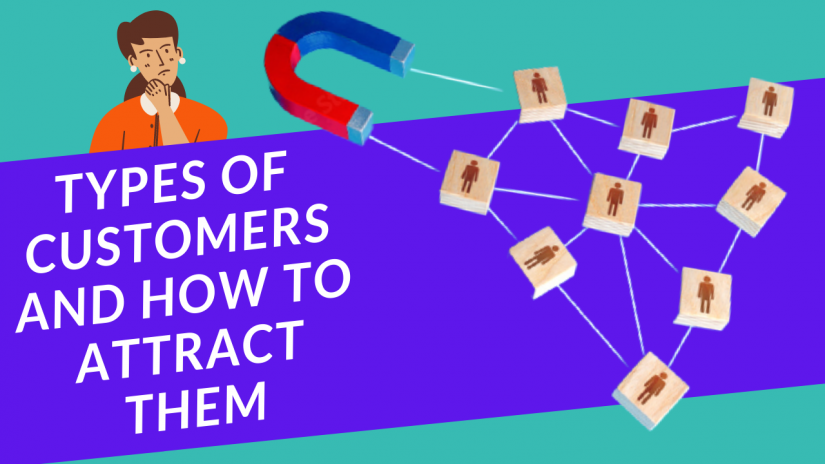Whether you run a retail store or you have an e-commerce website, you face broadly two types of marketing challenges. Your first hurdle is to popularize your shop and get more visitors. When you successfully complete this step you start to get a lot of visitors, but then it turns out that only a small number of them are actually buying things from your shop. There comes your second marketing challenge. How to convert visitors into customers!
To overcome this hurdle you will need a deep understanding of customer behaviour and psychology. Here particularly you need to understand why a person actually visits your shop and what turns him into a customer. When you understand these things you will be able to devise strategies to convert them into customers on your own.
Based on why a customer enters a shop and what relationship he has with you, we can divide them into 7 types. So read on to find about each of them and delve deeper into customer psychology.
Table of Contents
- 1. Need Based Customers
- 3. Impulsive Customers
- 2. Wandering Customers
- 4. Discount Hunters
- 4. New Customers
- 6. Loyal Customers
- 7. Dissatisfied Customers
- Final Words
1. Need Based Customers
These are those customers who come to your shop to buy a specific kind of product. They have a need for a particular product and they also have an idea of what kind of specifications they need in that product. They may compare several products from several shops and buy the one that satisfies them the best.
Converting Tips: To convert a need based visitor into your customer you need to satisfy him that you have exactly what he needs. For this, you should put in front of him a very detailed and lively description of the product. understand his needs and explain to him how your product and associated services can help. If you are an e-commerce website, make sure to add original photos and videos of the products.
3. Impulsive Customers

These are emotional customers and can randomly buy anything which makes them feel really good and excited.
Converting Tips: Impulsive customers may have entered your shop to buy a particular product. but they might also buy something else if they really like it or you present a product to them in that manner. An exciting deal or a limited stock tag also works in their case. Besides, you need to keep the checkout process easy for these customers as well.
2. Wandering Customers
These customers enter your shop for no particular reason. Maybe they are waiting for somebody and in the meantime, they decide to pass some time at your shop, or maybe they are a group of friends who just like to see things around, there may be any reason.
Converting Tips:
- These customers have no particular need in mind while entering your shop. However they can buy something if they see an exciting offer which is hard to resist for them. So make sure any offer you have is clearly visible to the visitors.
- They can also buy something if their eyes land on an amazing product. What you can do to increase the chances of their buying something is to tag some exciting products as limited stock. They may feel a sense of urgency and buy it right there.
- You need to make the buying process on the checkout process really easier for them otherwise as they may avoid getting into any hassle.
- Also try to make good relations with these customers, get them to subscribe to your emailing list, let them know all great things about your shops so that they visit you again.
Also read: An Ideal Set Of Steps For Salesmen To Follow
4. Discount Hunters

These customers are those who are especially looking for a special deal, discount or better price. They love to buy products but they don’t want to pay a lot of money. Or maybe a deal or discount simply excites them and they show an impulsive buying behaviour.
Converting Tips: You obviously need to give them special deals. You can keep throwing SALE! with attractive offers from time to time to attract them. Keep the sale limited in time like one day or two days so as to arouse a sense of urgency in them. Giving coupons and vouchers is also a good way of attracting such customers.
4. New Customers
Simply put, any customer who shops with you for the first time is your new customer.
Retaining Tips: Whenever a customer is with you for the first time, how to treat them with respect and ask them to come again. Show them a catalogue of all the products that you have and assure them of quality. Have interesting deals for your new customers and let them know. You can give them a coupon to give a discount on their next purchase. This will encourage them to buy again from you. it is also important to give them really good after-sales service so that they feel satisfied with purchasing from you.
6. Loyal Customers

A customer who purchases from you, again and again, is your loyal customer. A loyal customer is satisfied and happy with your product quality and services. Therefore he doesn’t look for any other shops but comes mostly to your place only.
Retaining Tips: Most of your business comes from loyal customers and therefore it is necessary to treat them with respect. Know them and their needs in detail. Throw special offers and deals just for them. Make them feel special in every way you can. And do everything to provide your best quality and services to them.
7. Dissatisfied Customers
These are those customers who for some reason, are not satisfied with your product and have come to return it.
Retaining Tips: Your relationship with these customers is at a delicate stage. Any single mistake from you at this stage can break this relationship and they might never return to your shop again. You need to handle this situation with utmost care and sincerely apologize to them for the wrong product delivered. Make them feel that you really care and let them know the reasons for mistakes and how you can work to solve the problems. Give them special attention, provide good service or replace their product. You can also give them a special discount to make them happy.
Final Words
Each customer is different with his unique sets of needs and reasons for visiting your store. Once you start to understand this difference between customers and learn to treat them differently based on their own kind of need, you will have more satisfied customers and consequently more sales.

